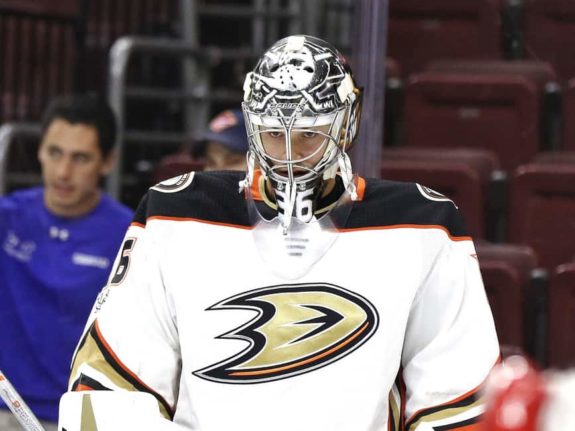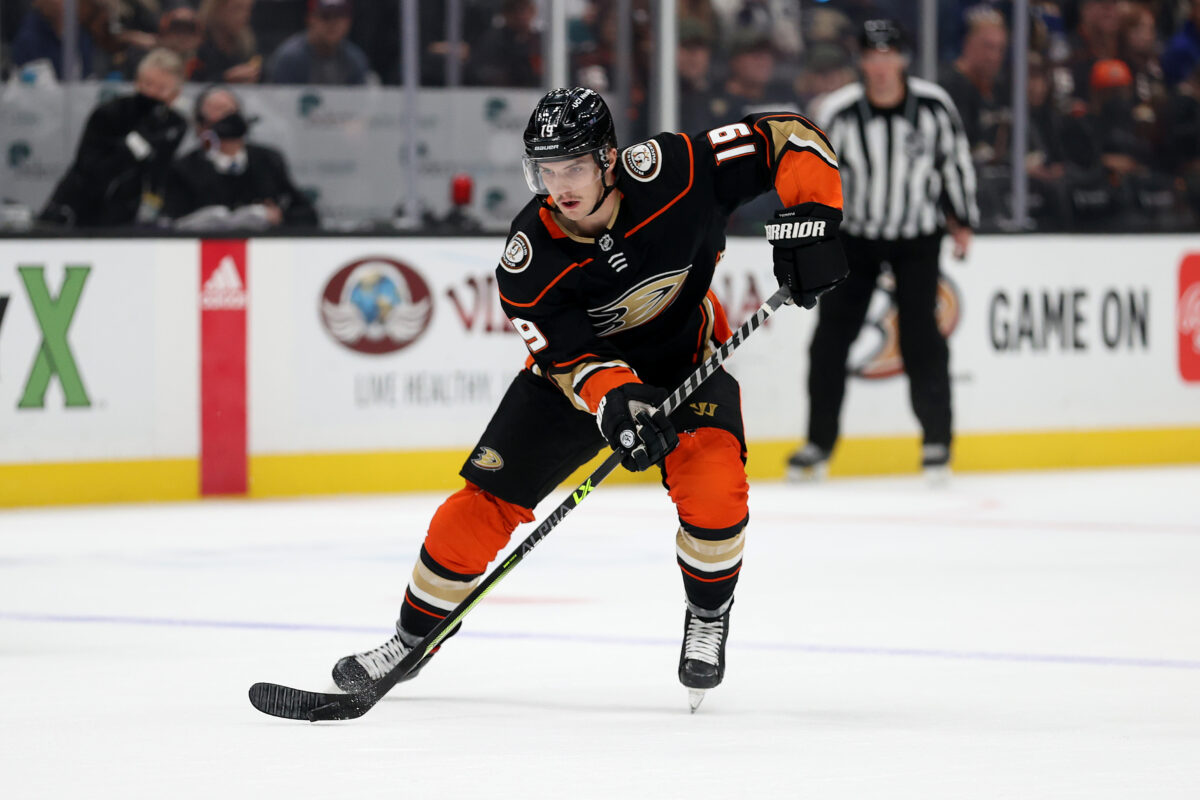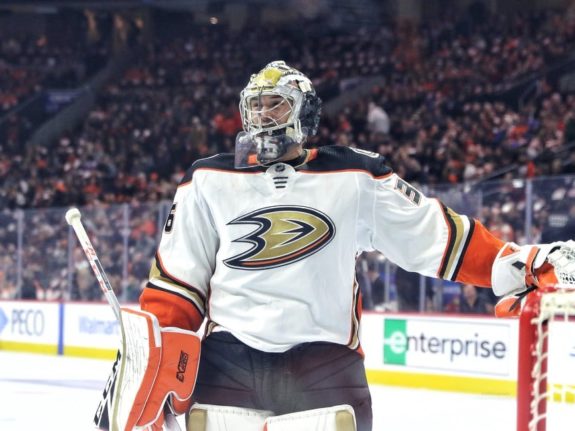The Anaheim Ducks‘ rebuild looks as if it has gone quicker than most have expected. People have been speculating that the team may plan on trading John Gibson after he signed that long extension. Though it could bring in a huge haul if a contending team were to try and pull that off, the Ducks would be wise to hold onto this elite talent and have him backstop a team that is getting closer to Cup contention.
Even though it may not be this season, the play of many on the team, including Gibson, suggests they are further along than they had hoped. The young players have stepped up in a major way and really helped the overall numbers of the team improve vastly. We aren’t even going to discuss potential trade options or destinations because Anaheim would be crazy to let a goalie like this go when their window is just about to open.
Gibson’s Contract Takes Him Into Ducks’ Stanley Cup Window
Contract & Comparisons
Gibson is in Year 3 of his eight-year, $6.4 million average annual value (AAV) contract he signed. It is the third contract he signed with the Ducks. The first was his entry-level deal, then a three-year bridge deal, now the payday. The way he has played throughout his career, $6.4 million looks like a steal. He will be in the Vezina Trophy conversation for years to come.

There are nine total goalies in the NHL making at least $6 million AAV. This season, only four of them, including Gibson, have played up to their contracts. The others are Sergei Bobrovsky, Andrei Vasilevskiy, and Jacob Markstrom. Of the group being paid the highest, only Gibson, Vasilevskiy, and Connor Hellebuyck have proven to be worth it.
Gibson has a modified no-trade clause, but it would make too much of an impact since it only includes 10 teams he wouldn’t want to go to, and probably non-contenders. That is only if the thought crosses the mind of the Ducks’ management.
Young Ducks’ Roster
Over the past couple of seasons, the Ducks have done very well in drafting and developing their young talent to be NHL ready and make the immediate impact they are all having. (“Ducks’ future looks bright as top prospects shine in Rookie Faceoff”, The Orange County Register, Sept. 20, 2021) Everything seems to have come together thus far this season, but I think they still have a bit to go.
Highly touted rookies like Trevor Zegras, Mason McTavish, and Jamie Drysdale will need a couple more years of development to play the game they are capable of in their prime. While the Ducks also have Max Comtois, Troy Terry, Sam Steel, Isac Lundestrom, Sonny Milano, Benoit-Olivier Groulx, Max Jones, Jacob Perreault, Simon Benoit, Josh Mahura, and Brendan Guhle all age 25 and under.
Some may take longer to develop and some have already shown signs of being a big part of the Ducks’ future. With all the young talent throughout the roster, it creates much-needed competition within four spots in the lineup and playing time. Comtois has shown he can be an impactful player, but his play this season has many people wondering what is going on and where can they go from here. Terry’s play speaks for itself, and he has stepped up and led this team early on in the goals and points department.

The lineup right now is spread out nicely with veterans and youth playing together, complementing each other. The rookies and younger players have great veteran leadership to be mentored by and that will help them in the long run in establishing a dynamic in the room when the veterans eventually all move on.
Related: NHL Stat Corner: Capitals, Oilers, Wild, Golden Knights, & Maple Leafs
It’ll be questionable as to whether impactful veterans like Ryan Getzlaf, Adam Henrique, Jakob Silfverberg, Rickard Rakell, Hampus Lindholm, Kevin Shattenkirk, and Josh Manson will be around in the coming years, but they would be wise to keep around half of them on the team. Henrique and Silfverberg may very well still be there, as they have two years left on their contracts after this season. The rest, though, are up in the air as to what the organization and the players want to do after this season when they are unrestricted free agents. Only Cam Fowler and Gibson are signed through 2024-25.
Gibson’s Stats Have Been Elite
This year, Gibson has not only received the help that he got when he put up elite numbers in the past, but he has done it throughout his career since he broke in as a young 20-year-old. He has a .912 save percentage (SV%) in the playoffs but hasn’t been there in four seasons, so it may be a different story this time he gets his next shot. Let’s break down his career and season numbers.
We’ll start with Gibson currently riding a six-game winning streak with two or fewer goals in five of them, as well as a shutout. (“Ducks’ John Gibson: Wins sixth straight start”, CBS Sports, Nov. 14, 2021) In 12 games, he is 8-2-2 with a 2.37 goals-against average (GAA) and .924 SV% with one shutout. He has a 58.3 quality start percentage — 53 percent is league average, while 60 percent is considered good. Gibson has a 4.7 goals saved above average (GSAA) this season as well. In basic terms, this means the number of goals he has prevented compared to the league average on the same number of shots.
The last two seasons can almost be considered a wipe when compared to the rest of Gibson’s career, as the team was very bad in front of him and his numbers suffered as a result.
He has 156 wins and 124 losses in his career with a 2.57 GAA. Those would more be considered team-impacted stats. Personal stats that have more to do with Gibson’s abilities are his .917 career SV%, a quality start percentage of 55.8, and a plus 46.1 GSAA. Once the young players on his team develop and learn the NHL better, his high GSAA combined with the team’s ability to defend will be a force to be reckoned with.

Gibson has had some great seasons in regards to different categories throughout his career, and at the age when goalies are in their prime, he is looking to return to that form.
He made two All-Star Games in 2016 and 2019, the William M. Jennings Trophy in 2015-16, as well as the all-rookie team the same year. Prior to this season, Gibson has had three seasons in the top-10 games played, so the Ducks wouldn’t need to spend on an expensive backup or a 1B option. In 21017-18, he finished 10th in the league with 31 wins.
For three consecutive seasons between 2017-20, Gibson recorded a ton of saves. He finished the seasons ranked seventh, sixth, and fifth, and is currently in second this season. Four times he finished a season in the top-10 in shutouts.
The 2016-17 and 2017-18 seasons for Gibson really stand out as he finished fifth and eighth in SV% with .924 and .926, while also ending the season ranked sixth and second in GSAA with 15 and 25. He was second in GAA at the conclusion of the 2015-16 season with 2.02, and fifth the following year with 2.22. He ranked very well all-time and compared to the current crop of goaltenders in the NHL in these stats. Gibson’s .917 SV% ranks his 15th all-time and eighth among active goalies. Not only that, but he’s 55th all-time in GAA at 2.57 and already 59th in GSAA. With his elite talent and averaging almost a plus-6 GSAA per season, he will climb the leaderboards quickly.
The Ducks should, and I believe will, make the right decision in keeping Gibson for a long time and be in the position to compete for a Stanley Cup sooner than later. Fans should be excited, and the team is very lucky to have this man with a solid cap hit stopping pucks for them.
